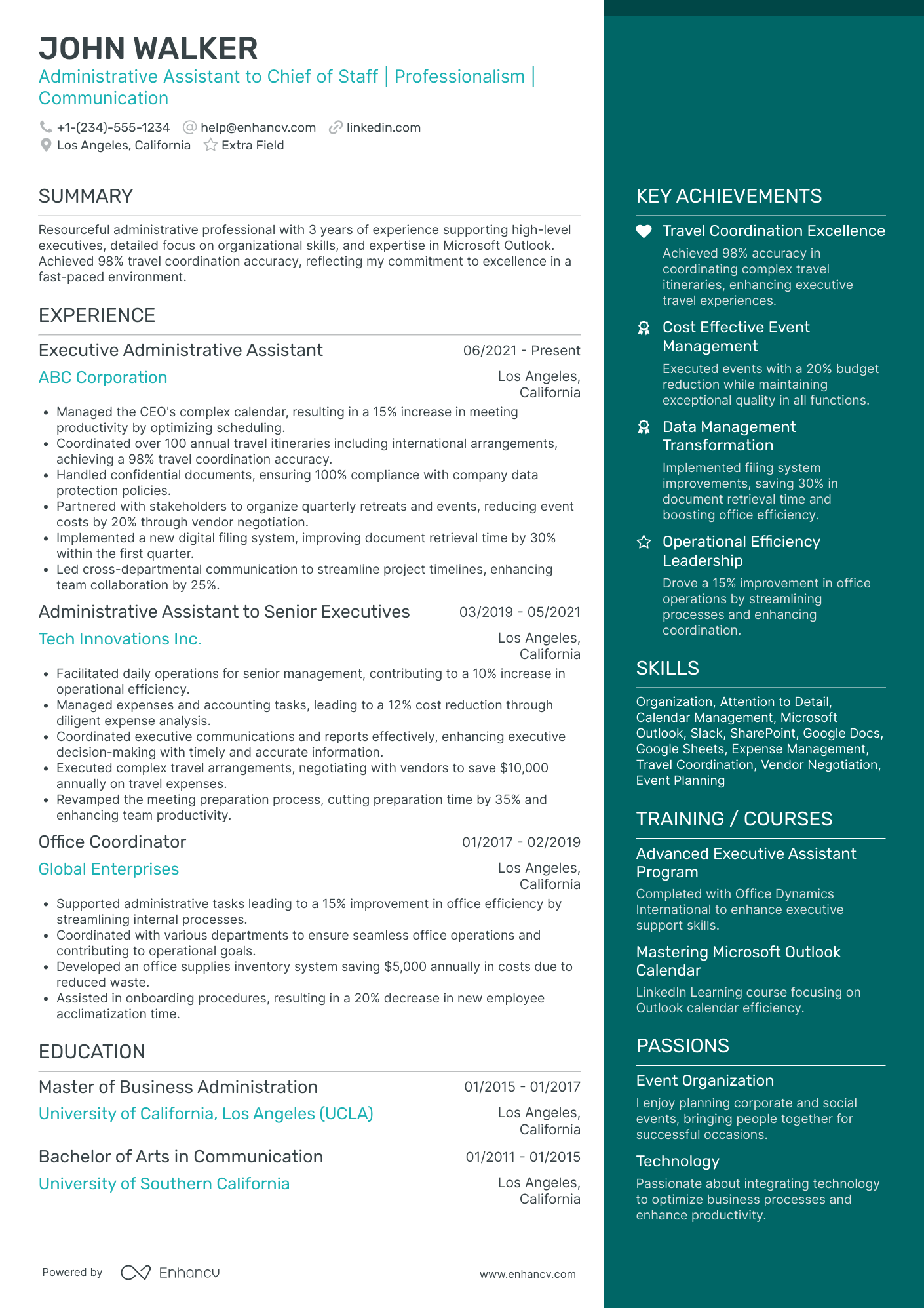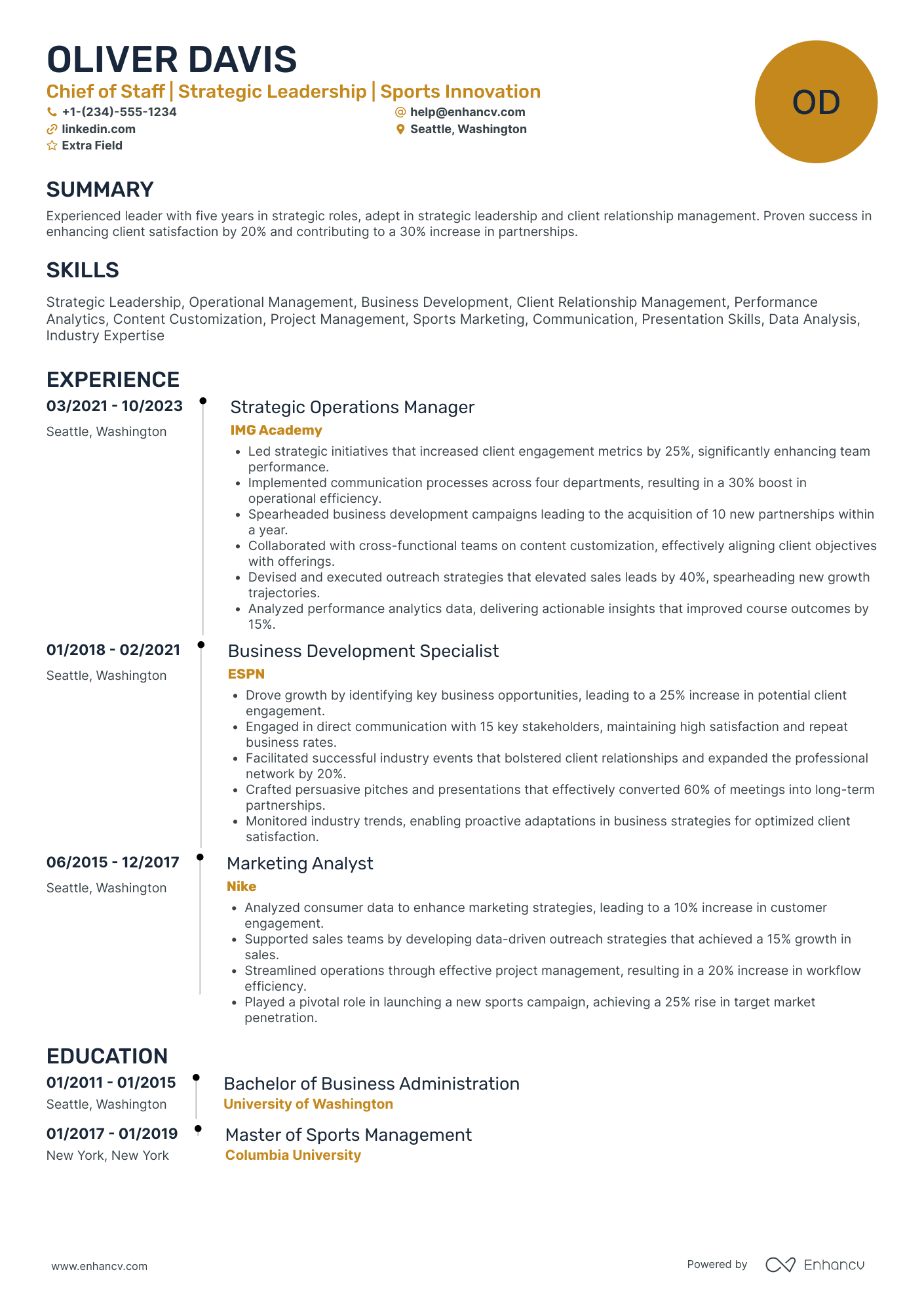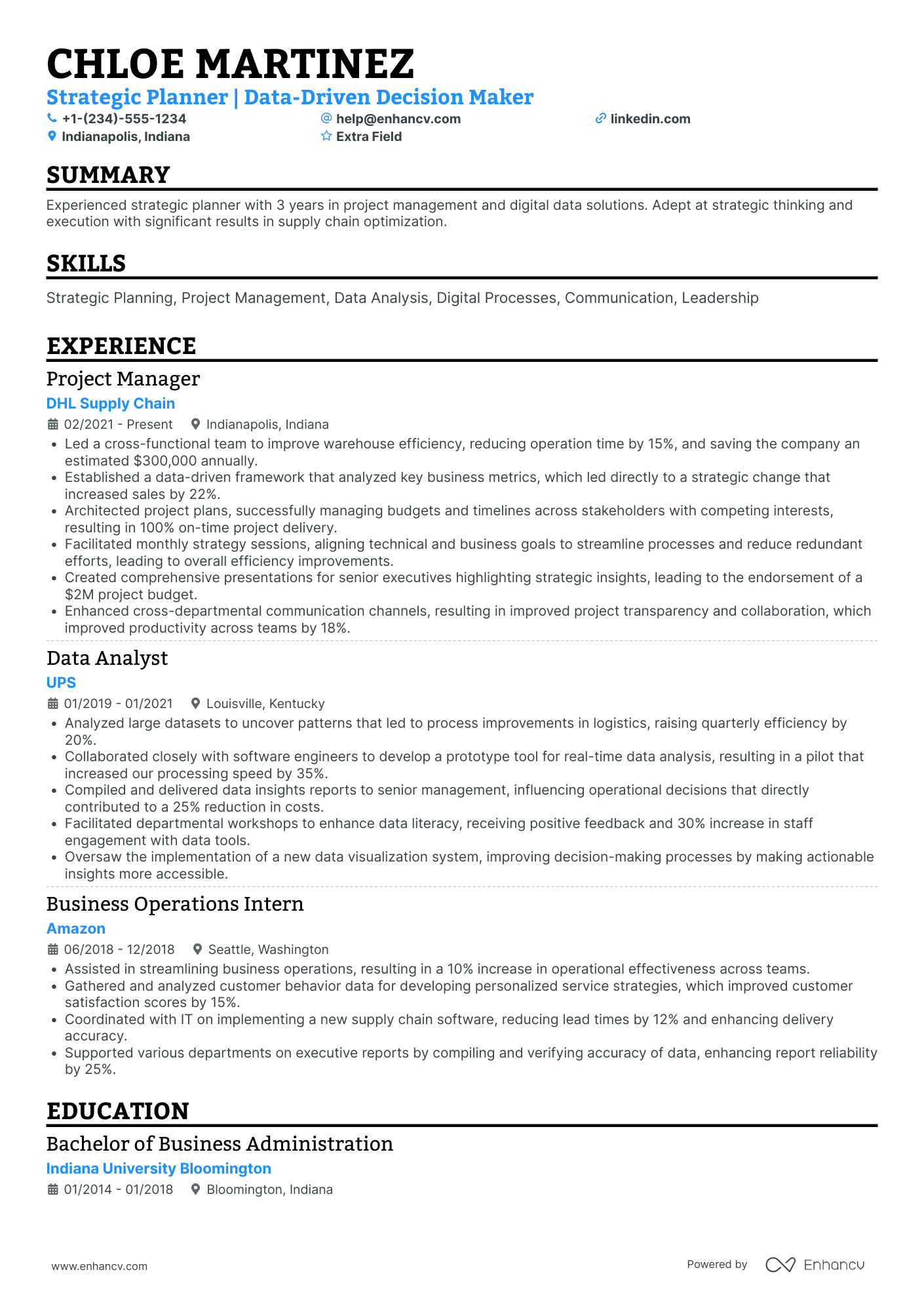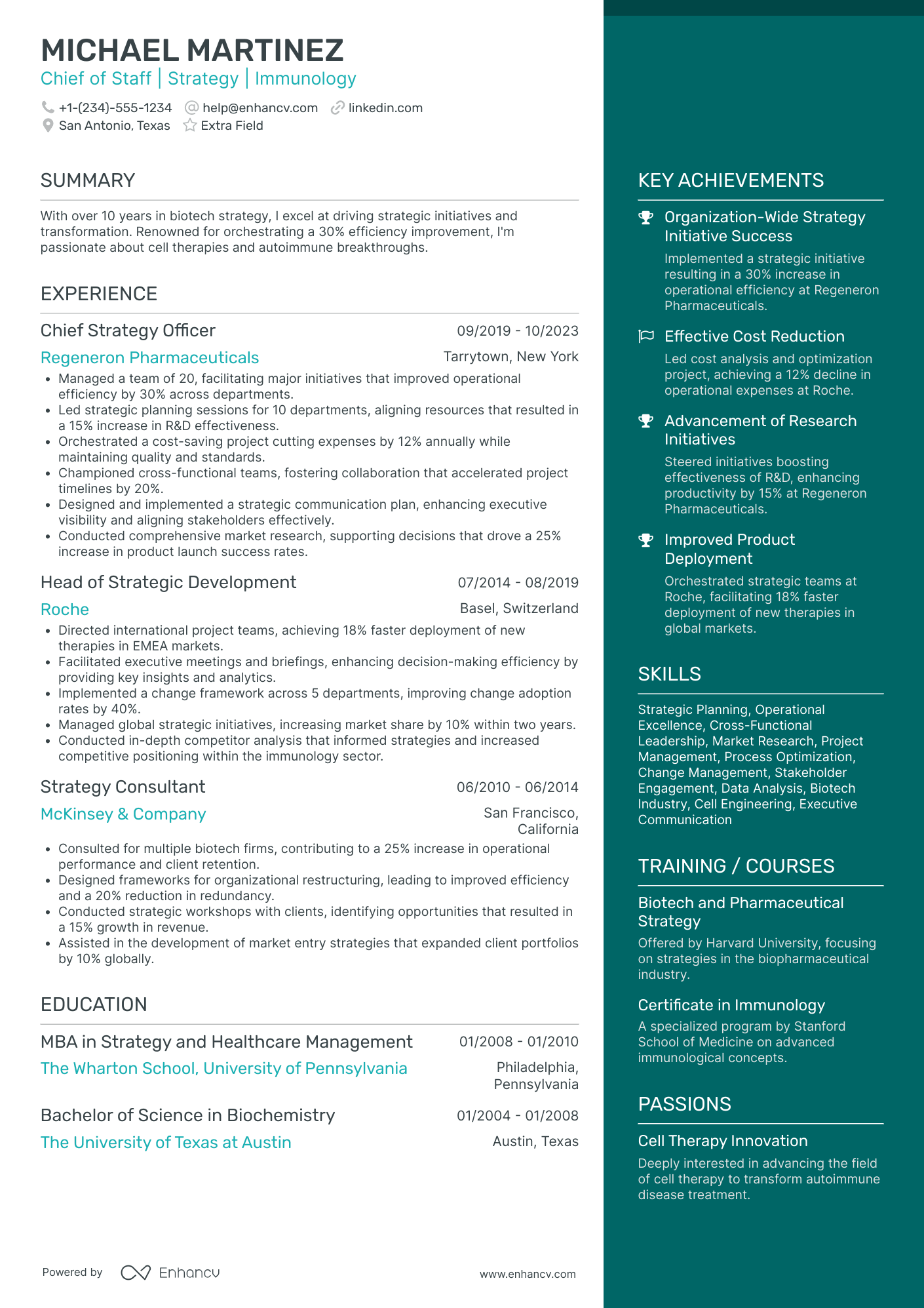Like a top-quality coach, a chief of staff can bring together executives, managers, and professionals from various departments to work towards a singular goal: to achieve the organization’s vision. To achieve this, a chief of staff must be an equal parts leader and diplomat, ready to pivot and try new things when the situation calls for it.
In your role as a chief of staff, you’ve overseen several initiatives, but you may have never had direct influence over a specific department. It's difficult to quantify your achievements on individual projects when you’ve acted in a more leadership role. In this article, you’ll learn how to quantify your experience on a chief of staff resume while also creating an impact with a potential hiring manager.
In this article, you’ll be provided with:
- An exemplary chief of staff resume format that effectively showcases the multifaceted nature of the role.
- Techniques to spotlight your role in spearheading major cross-departmental initiatives and projects.
- Strategies for detailing your expertise in utilizing organizational tools and methodologies that have bolstered company efficiency.
- Insights on emphasizing collaborations with executive teams, underscoring your capacity to drive decision-making and maintain strategic alignment.
In case you’re looking for a related role, browse the following guides below:
- HR Director resume
- Executive assistant resume
- Director of operations resume
- Strategy consultant resume
- General manager resume
Chief of staff resume example
Here’s what this resume does well:
- Quantifiable achievements: The use of specific percentages and dollar amounts helps validate accomplishments. Examples from the resume include:
- "Led strategy and operations team resulting in a 30% reduction in food waste and a 20% increase in profit margins."
- "Advised executive teams on market entry strategy resulting in $10M+ in new revenue."
- Relevant experience and skills: Having experience as a "Director of Strategy and Operations" and "Senior Strategy Consultant" directly applies to a chief of staff role. Skills such as "Project management", "Strategic planning", and "Leadership" are also vital for a chief of staff position.
- Awards and recognitions: Listing awards like "Outstanding Leadership Award" and "Team Collaboration Award" reinforces professional recognition and showcases expertise.
- Education and certifications: An MBA from a reputable institution like "Harvard Business School" suggests a sound foundation in business management and strategy, which is crucial for the role in question.
How to format a chief of staff resume
As a chief of staff, you bring order to the chaos in the workplace. In the same way that you organize your life and work, you should also organize your resume to provide the most impact. By following a specific formula, you are setting yourself up for success and highlighting those organizational skills that make you succeed in your role.
If you make small tweaks to your resume, you can help to present yourself in a better light. There are going to be dozens, if not hundreds of people applying for a position, but what can make you stand out from the rest of the pack is your unique skills and abilities. If you create a resume that highlights those skills, then you are going to be the cream of the crop.
Below, you’ll find some helpful tips to keep in mind when you’reformatting your resume:
- Reverse chronological format: Your future employers will be interested in your most recent experience. As you climbed your way up the corporate ladder, no doubt you’ve held other job titles other than chief of staff. Use a reverse chronological format to list your most recent experience first. This allows an employer to see where you currently are, while also providing them with previous experience to show how far you’ve come. By using this format, you can show an employer how ambitious you are, as well as the responsibilities that you’ve held in other roles outside of a chief of staff role.
- Header and contact info: Your header is at the top of your resume, and it provides an employer with all the pertinent information that they need to contact you. You should include contact information in your header, including your name, phone number, email, and location. You may also want to include your LinkedIn profile, as an employer can check to see who’s in your network.
- How many pages?: Let’s face it, as a chief of staff you’ve got a long list of previous roles under your belt. As a result, you may need to write a resume that is longer than one page. It’s not uncommon for those who have been in previous senior management roles to have a longer resume. The best rule of thumb is to keep your resume between one to two pages.
- File format: Unless otherwise requested, use the PDF file format. This is because thePDF file format is easier to share than a Word document and the photos and text won’t get shifted around.
Adjust your resume layout based on the market – Canadian resumes, for example, may follow a unique format.
Is your resume good enough?
Drop your resume here or choose a file. PDF & DOCX only. Max 2MB file size.
The top sections on a chief of staff resume:
- Professional summary: Your professional summary is an opportunity to explain your career achievements, unique experiences, and key qualifications that set you apart from other candidates. It can also be a great place to include your hopes and aspirations for your career as a chief of staff.
- Core competencies: Make sure to be specific instead of generic when listing your core competencies, while also quantifying them with actual numbers. Some core competencies as chief of staff could include strategic planning, project management, communication, and problem-solving
- Professional experience: When listing your professional experience, make sure to include the company that you worked for, the dates that you worked there, and some unique responsibilities that you had. Do your best to quantify any claim that you make.
- Education: Education can be a huge factor when getting a job. If you’ve attended a prestigious Ivy League school then you may have an opportunity to stand out with an employer. In some cases, you might’ve attended the alma mater of a hiring manager, and that allows you to build rapport.
- Certifications (if applicable): As a chief of staff, you need to stay on top of the current trends within your market to be competitive. You’ve likely taken some certification courses to increase your learning, which can help to make you stand out from other candidates.
- Strategic Initiatives: If you have been a part of some strategic initiatives within your company, make sure to include them in a separate section. If possible, include a link to a portfolio detailing all of the steps that you took to accomplish your goals.
What recruiters want to see on your resume:
- Demonstrated experience in strategic planning and execution at the executive level.
- Proven ability to collaborate and communicate effectively with C-suite members.
- Evidence of leading cross-functional teams or projects, showcasing leadership without direct authority.
- Specific accomplishments related to organizational growth, change management, or efficiency improvements.
- Familiarity or experience with the specific industry or sector the hiring company operates in.
How to write your chief of staff resume experience
Here’s the thing, your resume experience section will probably be the first thing that employers look at when they see your resume. In the highly competitive field of upper management, most employers will be specifically looking for how you’ve built up other well-known companies. That’s why it’s important to have a well-formatted and informative resume experience section.
One of the most common issues that people have when writing the experience section of their resume is that they simply list their job duties rather than accomplishments and achievements. Employers are looking to see what impact you’ve had and, through the use of dollar figures, percentages, and real-world data, will want you to explain how you made the company better. This is an opportunity to showcase how valuable you are as a chief of staff.
In addition, You will also want to include specific keywords that fit within your previous roles As a chief of staff, including keywords that fit within the market in which you worked. The first step that a recruiter will do when they find your resume is to scan it using ATS (applicant tracking system) software. They likely throw out any resumes that don’t Include any of the specific keywords or buzzwords that they’re looking for.
Below, you’ll find a list of two experience sections. One of them will be the correct way to fill out an experience section, while the other will be a resume section that falls below expectations. Use both examples as a guideline to create your own:
- •Helped to implement a comprehensive strategic planning process resulting in a significant revenue growth and increase in market share.
- •Found operational inefficiencies and created cost optimization measures.
- •Oversaw the successful execution of a high-impact project, which increased workflows between departments.
- •Provided support to the CEO by conducting in-depth market research and financial analysis.
What went wrong with this example:
- Inefficient and inelegant choices in words: The first thing that you notice here is that the author of this resume experience section uses the word “helped”. As soon as you do this, you take away all the force behind the claims that you’re making about yourself. If you use the word “helped”, you’re effectively saying that you played a secondary role in implementing change within your company. Start every single bullet point with a powerful action to add some force to the claims that you are making. Examples of active verbs include, guided, developed, directed, facilitated, advised, arranged, cultivated, maintained, and pioneered.
- No quantifiable examples: It’s great that the candidate helped to implement a “Strategic planning process” which helped to increase revenue growth in market share. But by how much did they increase revenue and market share? Your employer wants to know what significant impact you had, and the only way you can show that is through percentage points, dollar figures, and data points.
- •Orchestrated a comprehensive strategic planning process resulting in a 15% year-over-year revenue growth and a 20% increase in market share within a two-year period,
- •Identified operational inefficiencies and implemented cost optimization measures, resulting in a 12% reduction in operating expenses, contributing to a significant improvement in the company's profit margin
- •Oversaw the successful execution of a high-impact project to streamline cross-departmental workflows, resulting in a 30% increase in team efficiency and a 25% reduction in project delivery timelines.
- •Provided critical decision support to the CEO by conducting in-depth market research and financial analysis, enabling more informed decision-making and contributing to a 10% increase in shareholder value.
What went well in this example?
Other than the points mentioned above, what this resume example does well is that it is expanded and developed, while also being easy to read. Every single point that they make is backed up by a quantifiable example. For example, the author “orchestrated a comprehensive strategic planning process resulting in a 15% year-over-year revenue growth and a 20% increase in market share within two years.” A recruiter or a hiring manager could even be able to skim through your resume section looking for these percentages or data points that show how you’ve succeeded. Once you’ve grabbed the attention of a hiring manager, they’ll read more and see all the steps that you took to become successful.
How to quantify the impact on your resume
It’s important to quantify the impact you’ve made in previous roles because you can add credibility to the claims that you make. It’s the adage “You can talk the talk, but can you walk the walk?”. Many people can claim to have made a difference at their previous workplace, but how did you make a difference?
In addition, do not make any false claims or exaggerate what you’ve done in previous roles. Keep in mind that everything that you write on your resume may be fact-checked, and they might speak to your previous employer or other team members to help shed some light on some claims that you’ve made. If you pump up a percentage to make yourself seem more successful, the numbers don’t lie. And eventually, you’ll be found out.
Stick to what you’ve accomplished, and don’t take credit for what other people have done. As a chief of staff, everything that other people have accomplished falls under your guidance. However, an employer can spot when you’re trying to puff yourself up.
Examples of ways to quantify impact:
- Include percentage improvements in organizational efficiency or process optimization, showing your capability to drive measurable advancements.
- Mention dollar amounts saved or generated through strategic initiatives, demonstrating your direct impact on the company's bottom line.
- Highlight the number of cross-functional projects led, showcasing your ability to manage diverse teams and tasks.
- List specific metrics related to change management successes, revealing your proficiency in guiding businesses through transitions.
- Detail any growth in team size or resources you've managed, indicating your leadership capacity and scalability.
- Specify the number of C-suite executives or board members you've worked directly with, underlining your experience in high-level collaborations.
- Incorporate any quantifiable improvements in stakeholder or employee satisfaction, portraying your emphasis on people and culture.
How to list your hard skills and soft skills on your resume
As a chief of staff, you’ll likely have a long list of hard skills that you’ve picked up through many years of work experience. Hard skills, often called ‘technical skills’, are often gleaned through hands-on work, and involve skills applicable to a specific workplace. Whether it’s your unique experience in handling crises or distinct familiarity with customer relationship management software, you’ve made a vast difference through your technical, job-specific skills.
Yet, it’s easy to forget about all the soft skills that you’ve cultivated. Soft skills, commonly referred to as ‘people skills’, are often gained through experience working with people. Your leadership skills have allowed you to streamline operations and optimize workflows.
It’s beneficial to include both your hard skills and soft skills on your resume because it can help to show you in a well-rounded light. You can learn the mission and vision of the organizations and apply your knowledge to create KPIs and unique expectations for each department you oversee. This can in turn allow you to develop a fleshed-out organizational awareness of the company you work for.
4-step process for listing skills on your resume
- List all the skills that you possess: Include both the hard and soft skills that you’ve cultivated in your previous experience.
- Separate your skills between hard and soft skills
- Review the job description: Look at the job description and you’ll see specific skills which are required to fulfill the role. These are the skills that future employers are looking for on your resume.
- Edit the list for the skills that are most applicable to the job: Tailor the list so that it fits with the job that you’re applying for. You may need to get rid of some skills that don’t fit. For example, if your previous role involved a lot of technical IT support because you oversaw many operations of programmers and IT professionals, you may not need to list them if you’re applying for a role as chief of staff at a hardware company.
Best hard skills for your chief of staff resume
- Strategic planning
- Project management
- Data analysis
- Budgeting and financial forecasting
- Change management
- Process optimization
- Stakeholder management
- Risk management
- Performance metrics and KPIs
- Familiarity with CRM systems
- Business intelligence tools
- Contract negotiation
- Resource allocation
- Operations management
- Policy formulation
- Cross-functional team leadership
- Conflict resolution
- Organizational development tools
- Corporate governance
- Familiarity with ERP systems
Best soft skills for your chief of staff resume
- Effective communication
- Diplomacy
- Conflict resolution
- Leadership
- Emotional intelligence
- Active listening
- Critical thinking
- Adaptability
- Collaboration
- Decision-making
- Time management
- Influencing and persuasion
- Problem-solving
- Empathy
- Organizational awareness
- Resilience
- Stakeholder management
- Visionary thinking
- Negotiation
- Integrity
How to list your certifications and education on your resume
Although you may not realize it, your education can play a huge role in success. If you’ve attended a prestigious university or graduated from a highly sought-after program, that may signal to a hiring manager you’re going to excel in your role. It may also be an icebreaker during your interview, especially if you and your employer attended the same school. Sharing an alma mater can allow you to easily build rapport with a potential hiring manager, allowing you to stand out among the crowd.
In addition, if you’ve achieved an industry-wide certification, then that can allow you to gain an edge against other competitors who are new to the field. The chief of staff role is used in many fields and there may be tons of candidates applying for the position who have little to no experience in the field. For example, if you’ve led a charity or non-profit organization, you may wish to apply for a CFRE (Certified Fundraising Executive) to show competency in the logistics, ethics, and practical elements of receiving donations. Having that CFRE after your name will show that you have specific experience in optimizing the operations of a charity.
Here’s what you need to include when listing your education on your resume:
- The name of the degree
- The name of the school
- The location of the school
- The years you attended the school
- GPA (optional)
- Honors or extra-curricular involvement (optional)
Best certifications for your chief of staff resume
- Certified chief of staff Professional (CCSP)
- Certified Executive Leadership Coach (CELC)
- Certified Chief Executive Officer (CCEO)
- Certified Business Strategist (CBS)
- Certified Public Manager (CPM)
- Certified Organizational Change Manager (COCM)
- Certified Project Management Professional (PMP)
- Certified Chief Operating Officer (CCOO)
- Certified Human Resources Professional (CHRP)
- Certified Quality Assurance Professional (CQAP)
How to write your chief of staff resume summary or objective
Your resume summary or objective is the first time for you to showcase who you are, what goals you have, and what you’d like to do in your career before you get your first interview. A resume objective, also known as an objective statement, is a brief statement that is focused on how you will make an impact in the role that you’re applying for. Resume objectives are used for those who are new to a field or are applying for a position in which they have little experience. As a result, in a resume objective, you can include details on what you want to achieve or learn from the role that you’re applying for.
A resume summary or professional summary is an opportunity to dig a little deeper and showcase your career aspirations and goals. Your resume summary can go into a bit more depth about how your unique skills will benefit the company. A great piece of advice is to quantify using real data point dollar figures. In addition, you can showcase how you’re the best candidate to fill the position, you can also share your career aspirations.
A career summary best fits the role of the chief of staff, as to get this high managerial role, you likely have lots of experience under your belt. In that case, you can dig a bit deeper into what you’ve achieved and what you would like to achieve if you were to receive the role of chief of staff position you’re applying for.
Optimize your resume summary and objective for ATS
Drop your resume here or choose a file.
PDF & DOCX only. Max 2MB file size.
What went wrong with this resume summary?
It starts well by including some tangible numbers (70+ employees). But then tapers off into a more generic list of accomplishments the author has achieved. It doesn’t seem like it’s tailored to the specific role that the person is applying for, nor does it list any quantifiable examples of their achievements.
One other issue with this resume summary is that it doesn’t breathe life into the resume itself by showing more about the candidate. In a resume summary, you showcase a bit more of how you could make an enormous impact in the company you’re applying for. You don’t get that same level of enthusiasm from this summary.
What does this resume summary do well?
One of the best things about this resume summary is that the applicant backs up all of their claims with quantifiable data. Not only did they manage a team of 70+ employees, but they also helped to increase operational efficiency by 20% and reduce operational costs by $5 million. These are all tangible And quantifiable examples that your hiring manager will go back to during the interview or when contacting your references.
In addition, there is a single sentence at the end that shows that this resume summary was tailored to the position the person was applying for. That simple touch can show that you put effort into your resume and that you’re not just sending the same resume out to dozens of different jobs.
Additional sections for a chief of staff resume
A day in my life section
You may wish to include other sections in your resume to differentiate yourself from others applying for the position. For example, other executives have included a “day in my life” section for their resume, to showcase how they prioritize their work life and balance that with home life. This can help to show that you are an organized person who takes your role at their company seriously.
Publications or conferences
You may also want to include trade publications that you have written articles for or conferences which you’ve delivered presentations. By including publications and conferences, you’re showcasing that you are a thought leader in your industry. For example, if you led the keynote speech at an industrial manufacturing conference and your topic was ”Supply Chain Issues During the Pandemic”, you can show that you possess unique knowledge on the given topic. In addition, you may also want to include a link to an online video to showcase your public speaking skills.
Key takeaways
As a chief of staff, you have developed a long list of skills and abilities. Mold your resume to best highlight those skills and abilities to stand out from the pack. Below, you can find some of the key takeaways to help boost your resume:
- Include all the most pertinent information in your resume header and make sure that your resume header and cover letter header match.
- Include all education and certifications that apply to the job that you’re applying for.
- Use quantifiable percentages, dollar figures, and other data points. Back up any claims you make in your experience section or resume summary.
- Be sure to use keywords and other buzzwords in your resume so that your resume can be easily scanned through ATS software.
- Make up a list of all of your skills and abilities, and only include the skills that apply to the job that you’re applying for on your resume.
Chief of Staff resume examples
By Experience
By Role

























